Recent Posts
-
Real Crimes and the Coming Violence
September 6, 2025
-
Whither Modern Life?
June 27, 2025
-
What the Hell
June 18, 2025
-
As Darkness Engulfs Us
April 6, 2025
-
AI, Risk, and Work
January 17, 2025
-
“Things Are in the Saddle, and Ride Mankind”
December 29, 2024
-
Forgotten Futures in Seattle
December 12, 2024
-
Autocracy Defeats Neoliberalism
November 14, 2024
-
History… We’re Soaking in It!
October 2, 2024
-
A Numbing Spectacle
September 22, 2024
|
 We went to see the flamingos in the wild at the northern edge of Yucatan...  This vast structure is in Sayil, south of Uxmal, a lesser known/visited Mayan ruin. There’s a lot of funny hype about how the Mayan calendar predicts the end of the world in 2012, so we found ourselves going to Yucatan state in Mexico for New Year’s, and laughed that we were getting a head start on the end of the world!. What a beautiful place! And once upon a time, densely populated by urbanized Mayans, who lived in cities dependent on complicated water capture and storage schemes, with stunning temples and massive stone buildings covered in ornate sculpted hieroglyphs that tell stories of battles, kings, and conflicts of various types. We visited five different archeological sites, including world famous Uxmal and Chichen-Itza, and the lesser known Labna, Sayil, and Ek-Balam (the latter is also the name of a large undersea oil deposit in the Gulf of Mexico). We learned about Sac-Bé, the name given extensive “white roads” that connected the many Mayan towns and cities from the Yucatan down into Central America, rivaling the roads of the Incas in Peru/Ecuador/Bolivia, and the Roman roads across Europe.
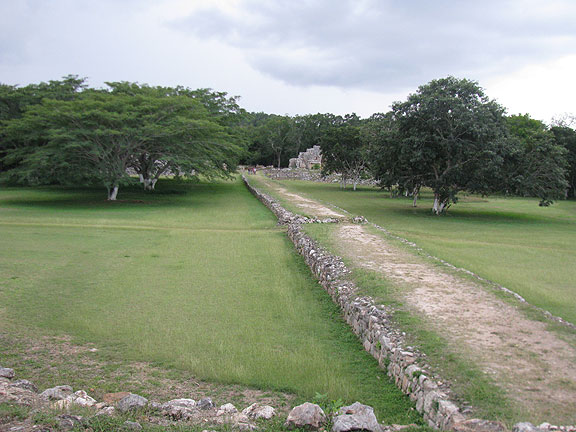 One of the Mayan roads that cut across the Labna ruins, south of Uxmal. 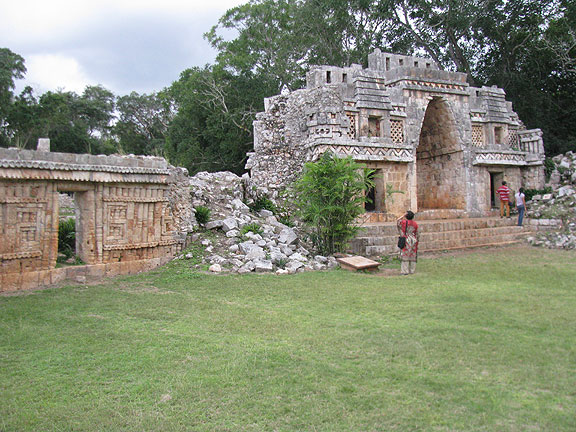 This iconic arch at Labna is used in a lot of tourist promotions. In a book called "The Lost Cities of the Mayans" I saw an image drawn in the 1840s of the same arch as it was just being dug out of deep jungle and soil. Continue reading Getting a Head Start on the “End of the World”!
“Progress consists of the application of intelligence to the reduction of effort and dependency, and the expansion of a sphere of idleness and individual freedom.”
—Franco “Bifo” Berardi, After The Future
The Occupy movement is going through a pivotal moment right now, with various camps—notably Oakland, Portland, and New York City—being destroyed by police action during the past few days. The punditocracy and the politicians are all hoping this will bring it to an end, but that is not going to happen. It is likely that the focus on camping and holding public plazas may give way to new tactics, but the newly vocal populations all over the U.S. are not going to be silenced just as they’ve rediscovered their voices.
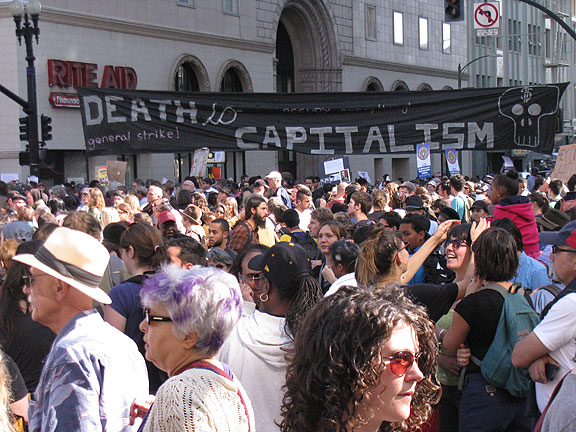 Arriving at 14th and Broadway in downtown Oakland on November 2, we were met with this amazing scene. 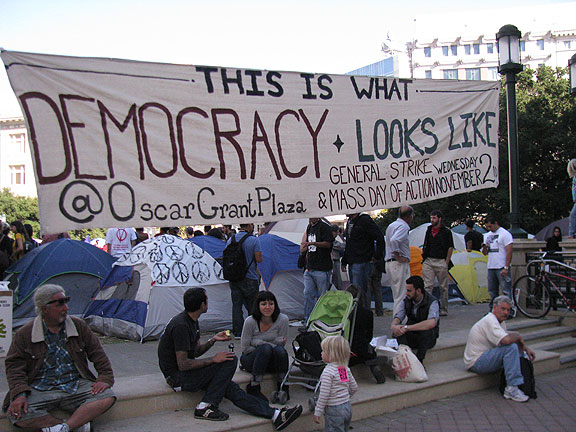 Walking around the area, the scenes of everyone together were endlessly inspiring. An historic day! In particular, the Oakland General Strike of November 2 was an historic event. For the first time in the U.S. an urban General Strike emerged from the new working classes, the precarious, the unemployed, the unorganized, and the poor, brought together 2,000-strong in the Occupy Oakland General Assembly on October 26 and voting 96% in favor. One week later it happened, and it was an amazing day.
General Strikes are not so rare in other parts of the world, of course. Several cities in Syria have been out for almost two weeks as I write. Italy and France have had many one-day general strikes in the past decades. But those have been led by giant trade union confederations, and kept under pretty tight control.
The Oakland General Strike was an opening salvo from an unexpected quarter: the “precariat” (a neologism made by combing precarious and proletariat). Local unions could not formally endorse the call in such a short time, and are often bound by no-strike clauses in their contracts. Nevertheless, rank-and-file members of the Service workers (SEIU 1021), the Teamsters, the Longshore and Warehouse Union (ILWU) and others, enthusiastically joined in during the day-long festival that gripped the center of Oakland, culminating in the mass marches towards dusk that shut down the Port of Oakland, the nation’s fifth largest. But organized labor was following, not leading this General Strike. The people filled the city center with music, banners, marches, humor, performance, food, yoga, meditation, childcare, art-making, and more. Rappers, hip-hop spoken word artists, and folk musicians all performed in the streets. Urban farmers showed up with free vegetables grown in the city’s reclaimed lots. Free valet bike parking was provided by local bicycle advocates. Dozens of economic and environmental justice activists were in the mix. The Oakland General Strike not only halted business as usual in much of Oakland, but demonstrated practical everyday alternatives that are already well entrenched in the area.
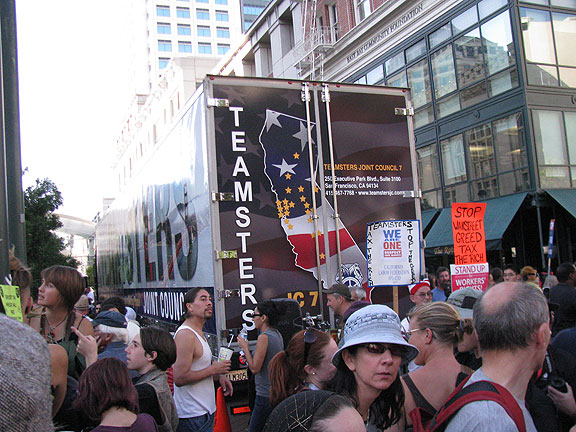 Much to my surprise, the Teamsters showed up with a truck load of hamburgers and hot dogs from the Alameda County Labor Council which they fed to all comers for hours.  This table offered free veggies from the East Oakland schools farmers market. 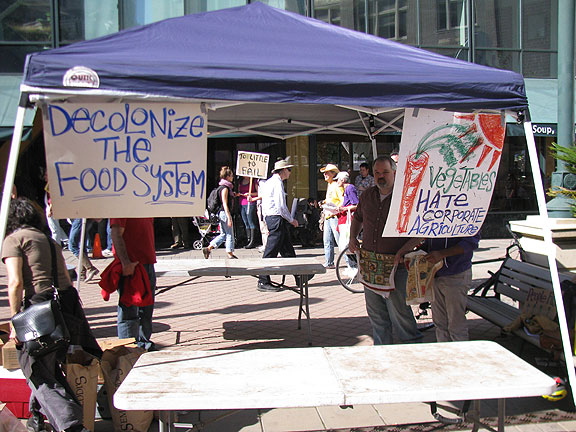 This booth had already given away all its food by the time I took this photo. Most hopefully, the Oakland General Strike excited everyone who turned out, leading to cascading feelings of solidarity and possibility, which in turn flows out of Oakland and across the networks of occupiers everywhere. Solidarity messages flowed in from as far away as Egypt, while Oakland suddenly found itself in the eyes of the world. The one-day strike was a powerful demonstration to local and national elites, but more importantly, it was a powerful demonstration to participants and allies, shifting imaginations about what is possible. Continue reading The Future Changes its Spots!
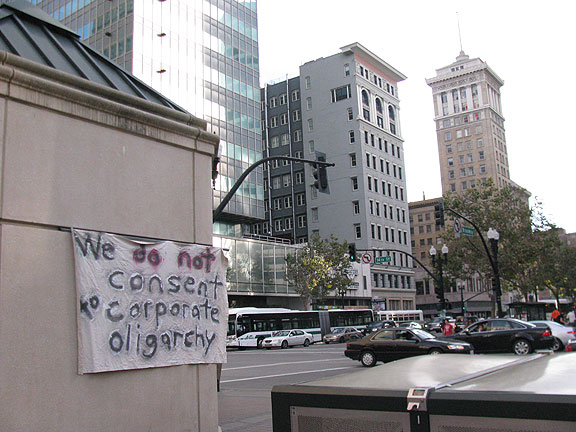 Banner hanging near 14th and Broadway in front of Oscar Grant Plaza across from Oakland's City Hall. We’re living in the midst of a fantastically exciting historic moment. I don’t know about you, but I have spent years thinking about these kinds of social ruptures, wishing for that sudden lurch in history when things change so fast. I spoke about this at the conclusion of many of the Nowtopia talks I gave around the world during the past 3 years, the palpable frustration that many attendees had with the snail’s pace of history. I reminded that history can suddenly accelerate, make a dramatic lurch… forward? Sideways? Backwards? You never know ahead of time, and you can’t predict what will catalyze it (for sure, the planned actions of a vanguardist minority cannot will it into being). Right now, clearly, we’re surging into exciting directions.
Like a sudden rain covering a desert landscape with incredible wildflowers after years of drought, the Occupy Wall Street movement has connected us across the world, but just as importantly has connected folks in the U.S. to our own histories from past decades. The triumphalist domination of the ultra-right in U.S. media and politics has done its utmost to deny, ridicule, and obscure the vital social movements and histories that entered the historic narrative loudly in the 1960s and 1970s, and never went away. Of course, the parties and organizations of the New Left and its aftermath crumbled, and most trade unions in the U.S have gone through massive shrinkage while accepting a junior role at the heel of the Democratic Party. But the social revolution that helped subvert the military and end the Vietnam War, that demanded equal rights for women, that advanced ethnic studies and racial diversity, that put pleasure and cooperation ahead of sacrifice and competition, and that began the reconfiguration of our material lives under the guiding sensibility of ecological sanity, deeply changed U.S. life. The Culture War still being fought so viciously by Faux News and its acolytes speaks to the ongoing power of these social transformations.
But many of us have lacked a political voice for more than a generation. We are not represented in our “representative democracy,” and many of us have long stopped expecting to be. There are very few politicians who speak for the values that we are already living by. Even if a “progressive” voice gets into office, they are drowned by the monied interests that surround them in a corrupted political system. In the larger scheme of things, these past decades have also seen the seizure of economic and political power by an increasingly brazen class of white-collar criminals who have done their best to subvert the rule of law, and will engage in any kind of fraud, even mass murder, to keep their power and this system intact. Obama has proven to be a very helpful servant to this gang, what with his refusal to prosecute the countless crimes of his predecessors, not to mention the impunity that financial criminals have enjoyed.
The system itself is broken, and that’s what the Occupy movement speaks to, loudly and clearly. The emergence of General Assemblies as the embodiment of a true direct democracy has been breathtaking, especially in its wide adoption across the middle of the country where we’ve all come to expect only reactionary conservatism. But these ideas haven’t fallen in from the sky, or emerged from a vacuum. They are the product of nearly a half century of organizing, of transforming how we live on a personal basis day to day, in addition to creating a panoply of new projects and cultural efforts. Formal political organizations withered away, perhaps deservedly, and it is only in the Occupy Movement that we are finding a collective political voice for the millions who have been left out, economically, culturally, and politically. Continue reading Return of the Repressed
|
Hidden San Francisco 2nd EDITION!

NEW 2nd EDITION NOW AVAILABLE!
Buy one here
(Pluto Press, Spring 2025)
|





















